Utah, one of the most geographically diverse states in the United States, boasts a rich and varied population of winter birds. As the temperature drops and snow blankets the landscape, many avian species seek refuge in the state’s diverse habitats.
From majestic raptors soaring high in the mountains to tiny songbirds fluttering around backyard feeders, winter in Utah is a time when bird enthusiasts can witness these feathered residents’ fascinating behavior and captivating beauty.
Whether you are an avid birdwatcher or appreciate the wonders of nature, exploring the world of winter birds in Utah is sure to ignite a sense of awe and appreciation for the incredible diversity of avian life in this cold season.
47 Winter Birds in Utah
Utah is home to various bird species, especially during the winter months when some species migrate to the region for warmer climates or to take advantage of food sources. Numerous bird species can be spotted in Utah during winter.
Here’s a list of 47 common winter birds you might encounter:
1. House Sparrow
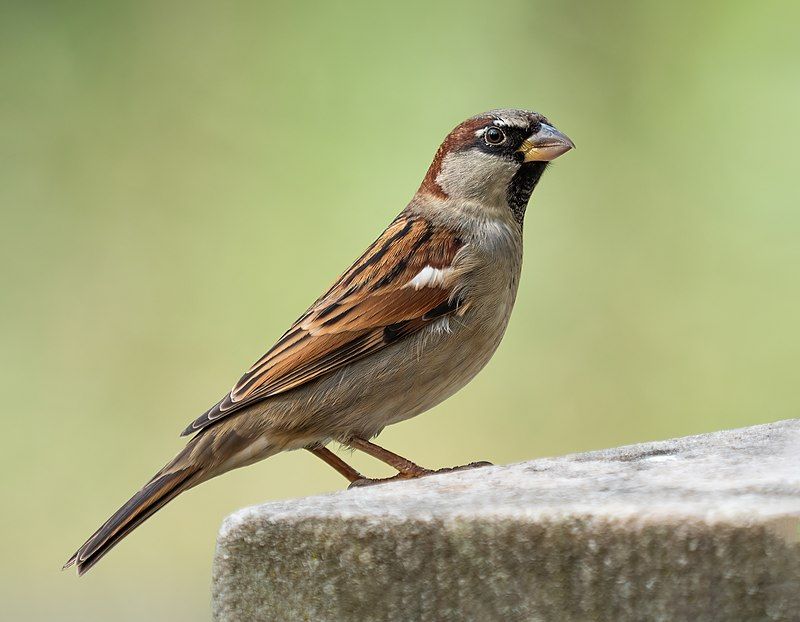
The house sparrow is a type of bird that belongs to the sparrow family called Passeridae. These birds can be found in many different parts of the world. They are pretty small, typically measuring about 16 cm in length.
In terms of weight, they usually range between 24 to 39.5 grams. Regarding their appearance, female and young house sparrows are generally colored in pale shades of brown and grey.
This coloration helps them blend in with their surroundings and provides them with some camouflage. On the other hand, male house sparrows have more vibrant colors.
They display black, white, and brown markings, making them easily distinguishable from the females and young birds.
The contrasting colors of the male house sparrows serve various purposes. Firstly, these colors help attract mates during the breeding season.
The brighter markings act as a visual signal to the females, indicating that the male is healthy and capable of providing for offspring.
These markings also play a role in defending territory and establishing dominance among other male sparrows. The house sparrow’s coloration is not only limited to their feathers. They also have distinct beak colors that differ between males and females.
| Kingdom | Animalia |
| Phylum | Chordata |
| Clade | Dinosauria |
| Class | Aves |
| Order | Passeriformes |
| Family | Passeridae |
| Genus | Passer |
| Species | P. domesticus |
2. Black-Capped Chickadee
The black-capped chickadee is a small songbird found in North America. It is known for its distinctive black cap and white cheeks.
This bird is not migratory, meaning it does not travel long distances during different seasons. The black-capped chickadee prefers to live in deciduous and mixed forests.
These types of forests provide the bird with the necessary habitat, such as trees and shrubs, where it builds its nests and finds food.
As a passerine bird, it belongs to the tit family, which is scientifically called Paridae. Interestingly, the black-capped chickadee holds special significance in certain regions.
It is the state bird of Massachusetts and Maine in the United States, symbolizing its importance to the local environment and culture.
Additionally, in Canada, specifically in the province of New Brunswick, it is recognized as the provincial bird. The black-capped chickadee is a small, nonmigratory songbird found in North America.
It thrives in deciduous and mixed forests and belongs to the tit family. Its significance is acknowledged through its designation as the state bird in Massachusetts and Maine and the provincial bird of New Brunswick.
| Kingdom | Animalia |
| Phylum | Chordata |
| Clade | Dinosauria |
| Class | Aves |
| Order | Passeriformes |
| Family | Paridae |
| Genus | Poecile |
| Species | P. atricapillus |
3. American Robin
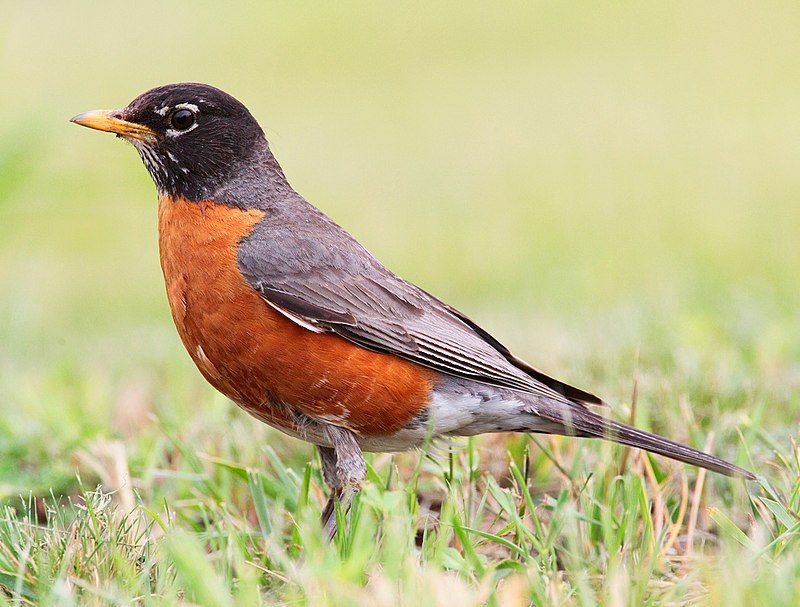
The American robin is a type of bird that migrates. It belongs to the valid thrush genus and the Turdidae family, a more prominent thrush family. It gets its name from the European robin because of its reddish-orange breast.
However, it must be noted that the American and European robin are not closely related. The European robin is a different species and belongs to the Old World flycatcher family.
Despite their similar names and physical characteristics, these two birds are not closely related regarding their genetic makeup.
They may share some similarities in appearance, such as the reddish-orange breast, but their evolutionary paths have taken them in different directions. The American robin is primarily found in North America, while the European robin is native to Europe and parts of Asia.
Both species have adapted to their respective environments and habitats over time.
The American robin is known for its ability to migrate long distances, often traveling south during winter and returning north for breeding season. Regarding physical characteristics, the American robin is larger than the European robin.
It has a grayish-brown back and a distinct reddish-orange breast, a defining feature of the species.
| Kingdom | Animalia |
| Phylum | Chordata |
| Clade | Dinosauria |
| Class | Aves |
| Order | Passeriformes |
| Family | Turdidae |
| Genus | Turdus |
| Species | T. migratorius |
4. Dark-Eyed Junco
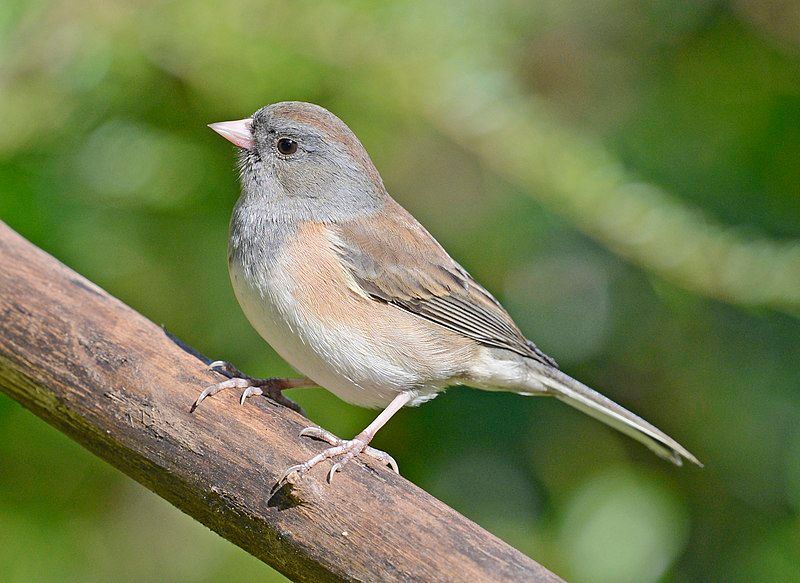
The dark-eyed junco is a type of bird called a junco. Juncos are small, grayish sparrows that live in the New World. The dark-eyed junco is found in many parts of temperate North America; during the summer, it even goes as far as the Arctic.
The dark-eyed junco is a species that has a lot of variation. This means that different individuals of this bird can look quite different from one another. It is similar to another species of sparrow called the fox sparrow in terms of its variability.
Despite being studied by scientists, the systematics of the dark-eyed junco are still not fully understood. Systematics refers to exploring the relationships between different species and their classification.
So, even though researchers have been trying to figure out how the dark-eyed junco fits into the larger picture of bird species, there are still some unanswered questions.
| Kingdom | Animalia |
| Phylum | Chordata |
| Clade | Dinosauria |
| Class | Aves |
| Order | Passeriformes |
| Family | Passerellidae |
| Genus | Junco |
| Species | J. hyemalis |
5. House Finch
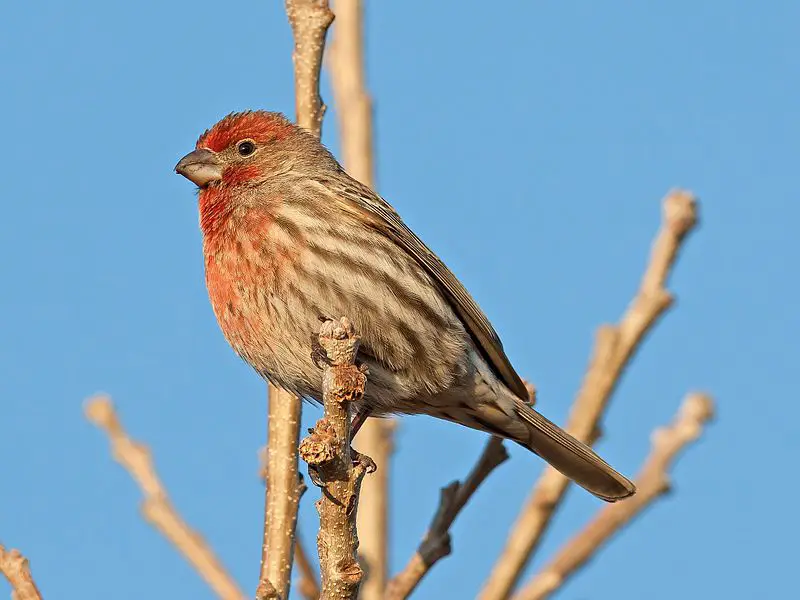
The house finch is a type of bird that belongs to the finch family called Fringillidae. This bird is originally from western North America.
However, it has also been introduced to other parts of the continent, such as the eastern half and Hawaii. The house finch is not the only bird in its genus.
It is grouped with two other American rosefinches, and all three are placed in the genus Haemorhous. The house finch is known for its beautiful red coloration, especially in males. The males have a reddish hue on their heads, chests, and backs.
Females, on the other hand, have more muted colors with brownish feathers. These birds are relatively small, measuring about 12 to 16 centimeters in length. They have short wings and a slightly notched tail.
Their beaks are conical and designed for cracking open seeds, their primary food source. House finches are highly adaptable and can be found in various habitats, including urban areas, forests, and grasslands.
They are known for their melodic songs, which they use to communicate and attract mates. Breeding season for these.
| Kingdom | Animalia |
| Phylum | Chordata |
| Clade | Dinosauria |
| Class | Aves |
| Order | Passeriformes |
| Family | Fringillidae |
| Genus | Haemorhous |
| Species | H. mexicanus |
6. Northern Flicker
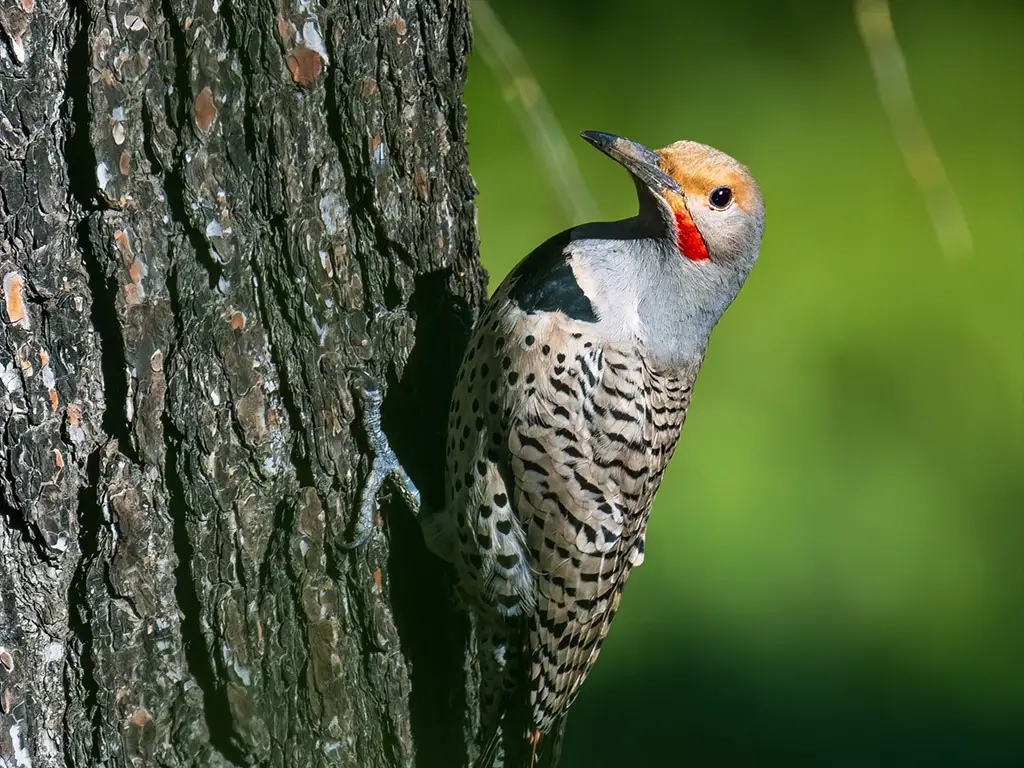
The northern flicker is a bird that belongs to the woodpecker family. It is not a very large bird but also not too small. The northern flicker can be found in many parts of North America.
It is also native to some areas in Central America, such as Cuba and the Cayman Islands. One exciting thing about the northern flicker is that it is one of the few woodpecker species that migrate.
Migration means these birds travel from one place to another during different seasons. They do this to find food and suitable habitats.
The northern flicker migrates to different regions depending on the time of year. During the breeding season, which is usually in the spring or summer, the northern flicker can be found in many parts of North America.
They build their nests in trees and use their strong beaks to create holes in the wood. These holes are called cavities and serve as their homes. Northern flickers are known for their distinctive markings.
They have a brown body with black spots, and their wings have a white patch easily visible when flying. Another unique feature is the red or yellow coloration on the underside of their wings and tail.
| Kingdom | Animalia |
| Phylum | Chordata |
| Clade | Dinosauria |
| Class | Aves |
| Order | Piciformes |
| Family | Picidae |
| Genus | Colaptes |
| Species | C. auratus |
7. American Goldfinch
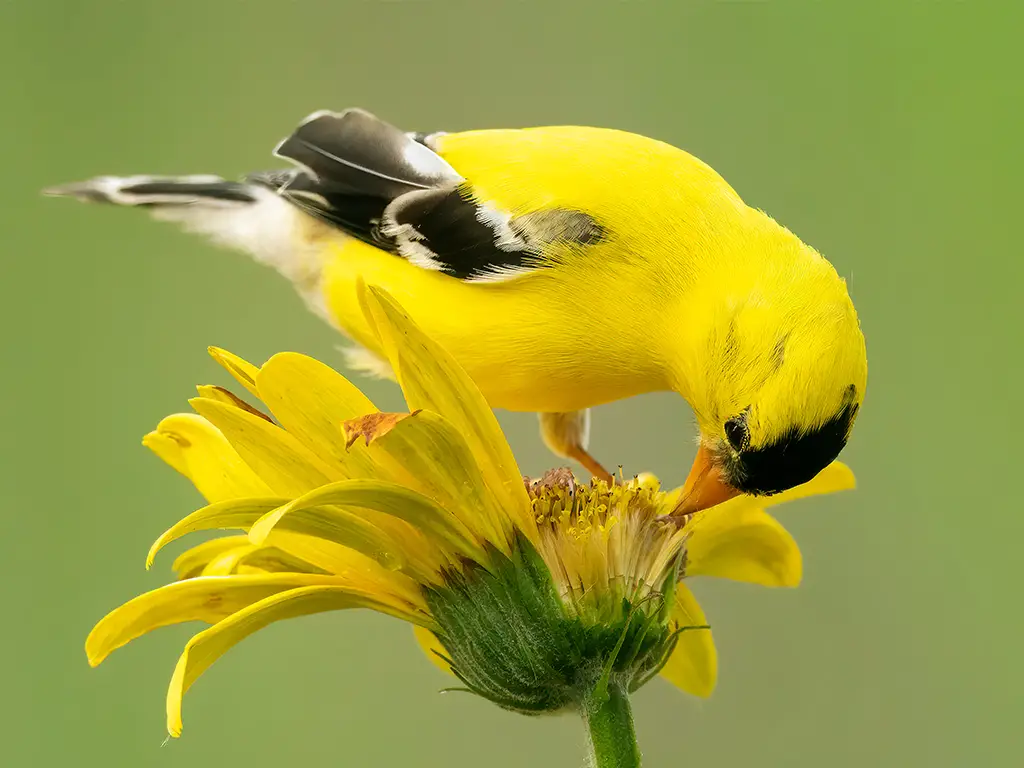
The American goldfinch is a type of bird found in North America.
It belongs to the finch family, a group of small birds known for their colorful feathers and pleasant songs. This bird is migratory, meaning it travels from one place to another depending on the time of year.
When they mate and lay eggs during the breeding season, the American goldfinch can be found in areas ranging from mid-Alberta in Canada to North Carolina in the United States. When the weather gets colder in the winter, the American goldfinch migrates to a different region.
They move from just south of the Canada–United States border and travel down to Mexico.
This helps them find better conditions for survival as the temperature and food availability change with the seasons. The reason for their migration is mainly related to the availability of food.
During the breeding season, the American goldfinch feeds on insects and seeds from plants like sunflowers and thistles.
These food sources are abundant in the areas where they breed, providing them with the necessary nutrients for reproduction and raising their young. However, these insects and plants may not be readily available in their breeding grounds during the winter.
| Kingdom | Animalia |
| Phylum | Chordata |
| Clade | Dinosauria |
| Class | Aves |
| Order | Passeriformes |
| Family | Fringillidae |
| Genus | Spinus |
| Species | S. tristis |
8. Black-Billed Magpie
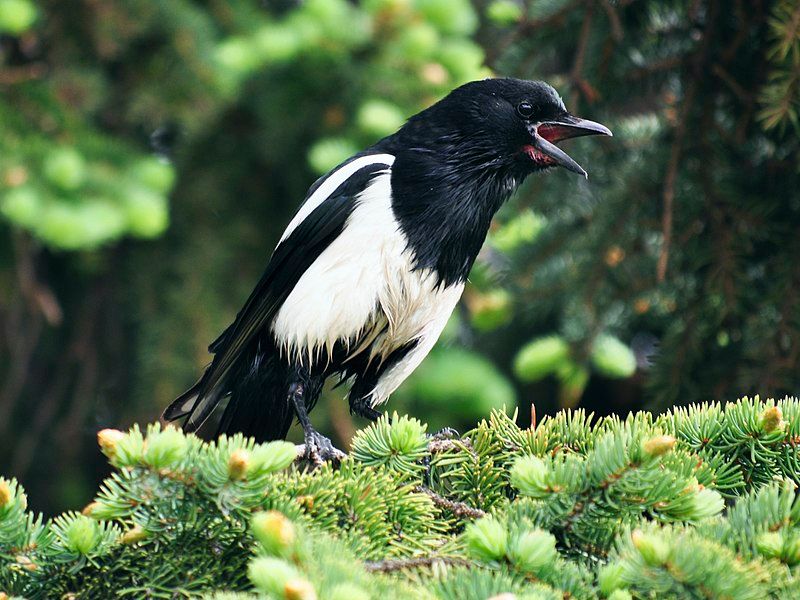
The black-billed magpie is a type of bird that belongs to the corvid family. It can be found in the western part of North America. Another name for this bird is the American magpie. In terms of appearance, the black-billed magpie is primarily black and white.
Its body is mainly black, but it also has areas of white feathers. These black and white colors create a striking contrast. The wings and tail of the black-billed magpie have black feathers as well.
However, looking closely, you may notice that these black areas have hints of iridescent colors like blue or blue-green.
When the light hits its feathers, these colors give the magpie a beautiful shimmering effect. The black-billed magpie is a visually appealing bird due to its contrasting black and white colors.
The iridescent hints of blue or blue-green on its wings and tail add extra beauty to this already remarkable creature.
| Kingdom | Animalia |
| Phylum | Chordata |
| Clade | Dinosauria |
| Class | Aves |
| Order | Passeriformes |
| Family | Corvidae |
| Genus | Pica |
| Species | P. hudsonia |
9. Common Starling
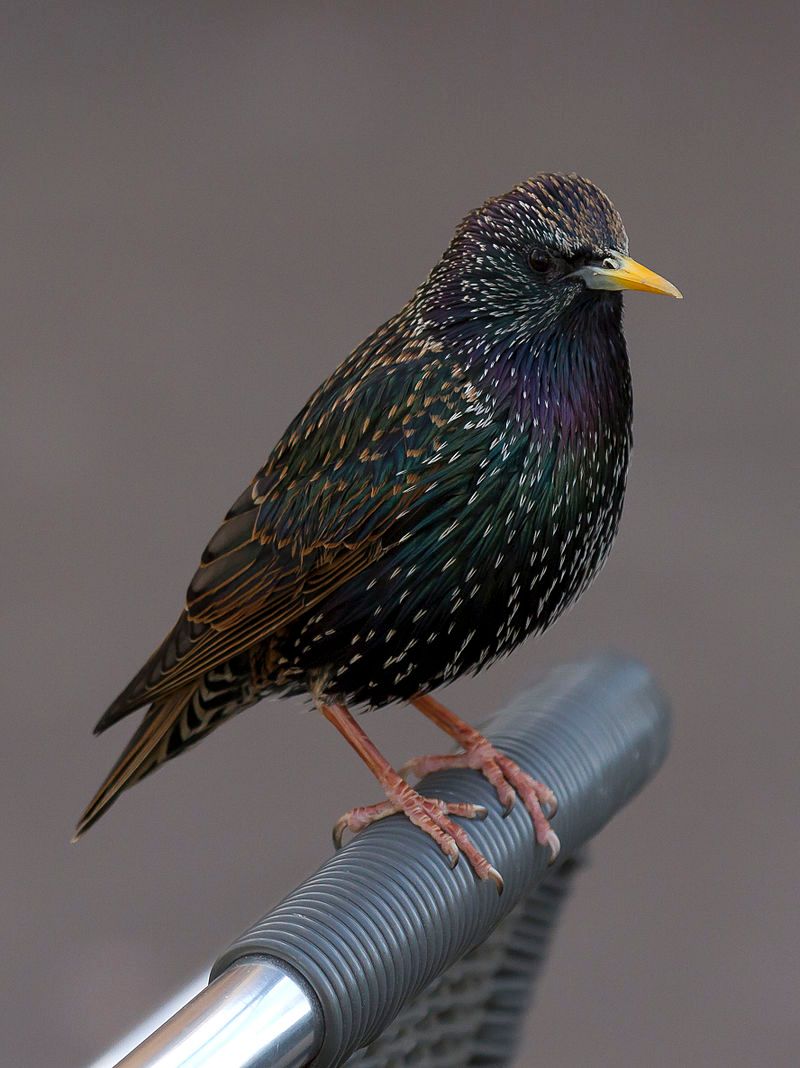
The common starling is a type of bird found in various regions. Depending on the location, it is referred to by different names. It is known as the European starling in North America, while it is called the starling in Great Britain and Ireland.
This bird belongs to the starling family, scientifically known as Sturnidae. The common starling is classified as a passerine bird with a medium-sized build. Passerine birds are characterized by having feet adapted for perching, and they make up the most significant order of birds.
The starling family, to which the common starling belongs, is known for its diverse species worldwide. The common starling is known for its unique features and behaviors. It has a sleek and shiny black plumage with speckled spots, which gives it a distinct appearance.
The bird’s feathers can also appear iridescent in certain lighting conditions, showcasing shades of green and purple. One of the remarkable aspects of the common starling is its ability to mimic sounds and voices.
It has various vocalizations and can imitate multiple sounds in its environment, including other bird calls, human speech, and even mechanical noises.
| Kingdom | Animalia |
| Phylum | Chordata |
| Clade | Dinosauria |
| Class | Aves |
| Order | Passeriformes |
| Family | Sturnidae |
| Genus | Sturnus |
| Species | S. vulgaris |
10. Eurasian Collared Dove
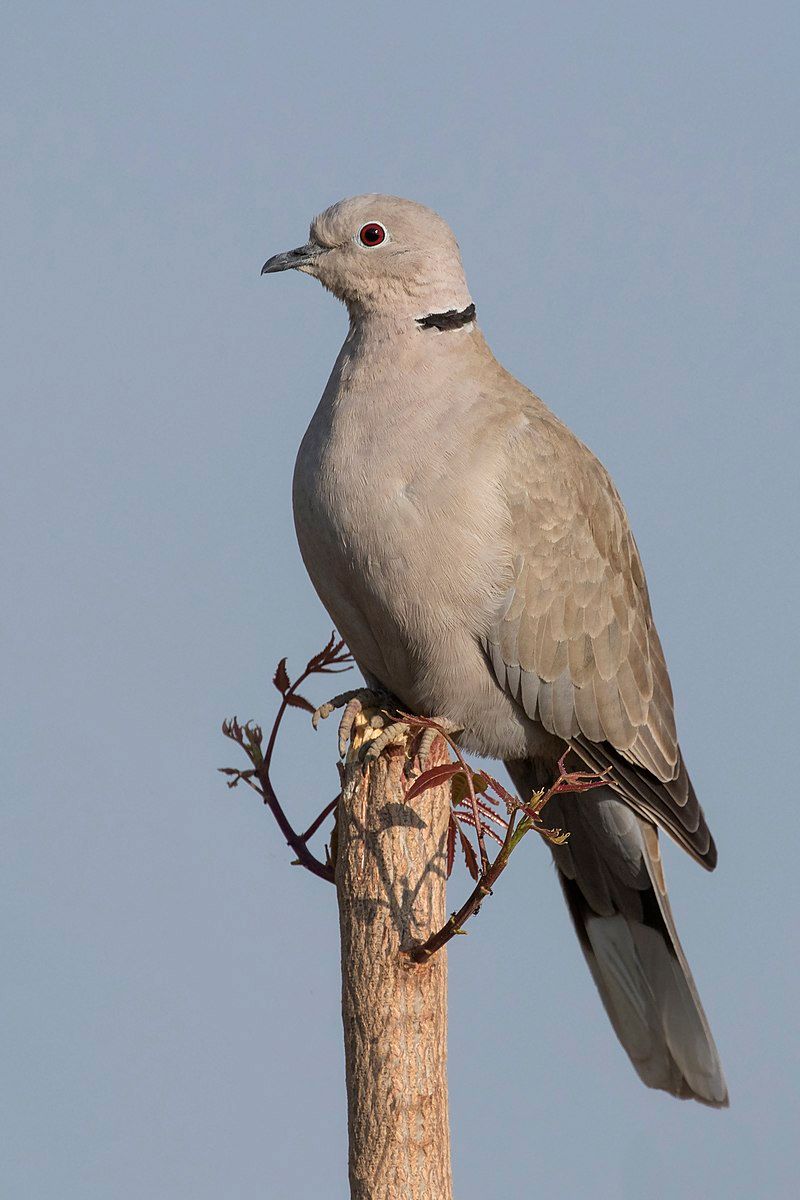
The Eurasian collared dove is a type of bird. It is naturally found in parts of Europe and Asia. However, people have brought this dove species to other places as well.
Japan, North America, and some islands in the Caribbean have now become home to the Eurasian collared dove. Initially, the Eurasian collared dove lived only in Europe and Asia. These areas were its natural habitat.
But at some point, humans decided to introduce this bird species to other parts of the world. They wanted to see if the dove could survive and thrive in new environments—one of the places where the Eurasian collared dove was introduced in Japan.
People brought these doves to Japan, which is located in East Asia.
It is interesting to think about how the doves might have adapted to Japan’s different climate and surroundings compared to their original habitat—another place where the Eurasian collared dove was introduced in North America.
With its diverse landscapes, this vast continent became a new home for these doves.
It would be fascinating to study how the doves have spread across North America and found their niche in different regions. Apart from Japan and North America, the Eurasian collared dove was also brought to islands.
| Kingdom | Animalia |
| Phylum | Chordata |
| Clade | Dinosauria |
| Class | Aves |
| Order | Columbiformes |
| Family | Columbidae |
| Genus | Streptopelia |
| Species | S. decaocto |
11. White-Crowned Sparrow
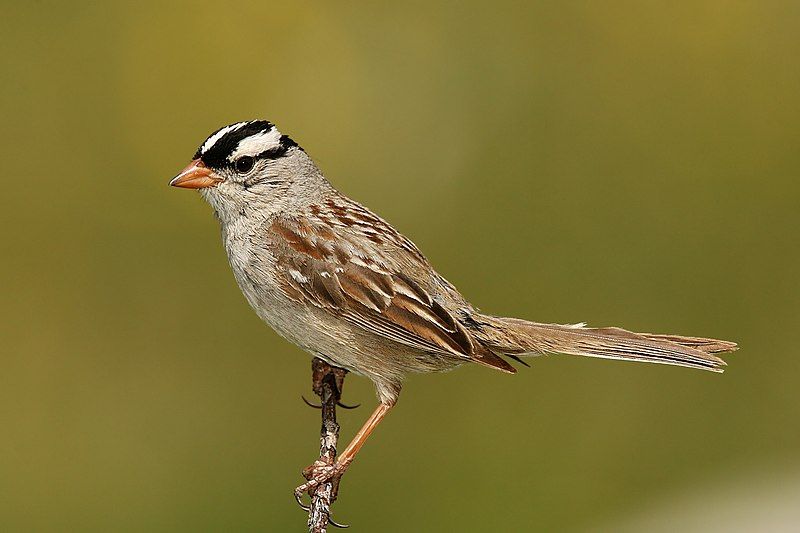
The white-crowned sparrow is a type of bird found in North America. It belongs to the passerine bird family, which means it is a perching bird.
This species is not too big or too small but falls into the category of medium-sized birds. One distinctive feature of the white-crowned sparrow is its grey face. The color of its face is different from the rest of its body, making it easy to identify.
The grey color gives the bird a unique and exciting appearance. Another characteristic of this species is the black and white streaking on its upper head. The streaks create a pattern that adds to the bird’s overall appearance.
These streaks are alternating black and white lines, giving the bird a striking and beautiful look. The black and white streaking on the white-crowned sparrow’s upper head is a notable feature because it contrasts with the rest of its body.
This contrast makes the bird stand out and catch the eye of observers. Seeing how nature has designed this bird with such distinct markings is interesting. The white-crowned sparrow’s grey face and black and white streaking on the upper head are unique to this species.
These characteristics help distinguish it from others.
| Kingdom | Animalia |
| Phylum | Chordata |
| Clade | Dinosauria |
| Class | Aves |
| Order | Passeriformes |
| Family | Passerellidae |
| Genus | Zonotrichia |
| Species | Z. leucophrys |
12. Lesser Goldfinch
The lesser goldfinch is a tiny bird found in the Americas. It belongs to a group called the New World goldfinch clade, along with two other species called the American goldfinch and Lawrence’s goldfinch.
All three species are part of the Spinus genus. One attractive characteristic of the lesser goldfinch is that the males have a black forehead. This feature is unique to male lesser goldfinches and is not present in females.
So, if you see a goldfinch with a black forehead, you can be sure it is a male lesser goldfinch. The black forehead is an important identification feature for distinguishing between male and female lesser goldfinches.
It helps birdwatchers and researchers determine the gender of these birds.
When observing a group of lesser goldfinches, they can easily spot the males with distinctive black foreheads. It is worth noting that this black forehead trait is not exclusive to the lesser goldfinch.
Both the American goldfinch and Lawrence’s goldfinch also possess this characteristic.
This similarity in appearance suggests a close evolutionary relationship between these three species. By studying these New World goldfinches, scientists can gain insights into their evolutionary history and understand how different.
| Kingdom | Animalia |
| Phylum | Chordata |
| Clade | Dinosauria |
| Class | Aves |
| Order | Passeriformes |
| Family | Fringillidae |
| Genus | Spinus |
| Species | S. psaltria |
13. Red-Winged Blackbird
The red-winged blackbird is a type of bird that belongs to the passerine family called Icteridae.
It is commonly found in various parts of North America and a significant portion of Central America. Passerines are a diverse group of birds known for their musical and complex songs.
They have specialized vocal organs that produce a wide range of sounds. The red-winged blackbird is easily recognizable due to its distinct appearance.
The male red-winged blackbird has glossy black plumage and bright red patches on its wings, which give it its name.
On the other hand, the female red-winged blackbird has a more subdued appearance with brown feathers and streaks. These birds have a unique habitat preference, as they are commonly found in wetlands, marshes, and areas with tall grasses.
They are skilled at perching on tall plants and reeds, where they can easily spot their prey and potential predators. Red-winged blackbirds primarily feed on insects, seeds, and grains. They use their sharp beaks to catch insects on the fly and extract seeds from plants.
During the breeding season, they may consume small vertebrates such as frogs and tadpoles.
| Kingdom | Animalia |
| Phylum | Chordata |
| Clade | Dinosauria |
| Class | Aves |
| Order | Passeriformes |
| Family | Icteridae |
| Genus | Agelaius |
| Species | A. phoeniceus |
14. Song Sparrow
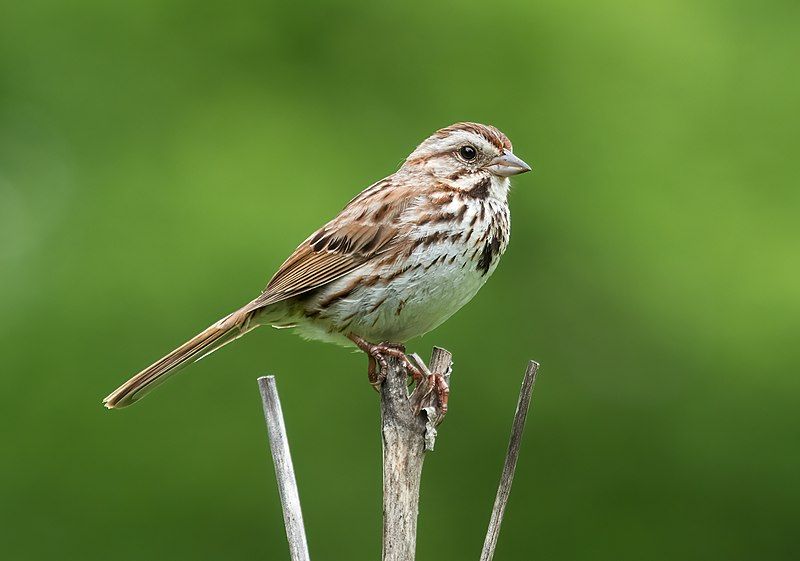
The song sparrow is a type of sparrow found in North America. It is considered to be medium-sized in comparison to other sparrows. Out of all the sparrows native to North America, the song sparrow is known to be one of the most abundant species.
This means that there are a large number of song sparrows in the wild. Not only is the song sparrow abundant, but it is also quite variable. This means that there can be different variations or types of song sparrows. They may have slight differences in appearance or behavior.
In addition to being abundant and variable, the song sparrow is also adaptable. This means that it can adjust well to different environments and conditions. It can thrive in various habitats, such as grasslands, marshes, and urban areas.
The adaptability of the song sparrow allows it to have a wide range of distribution. It can be found in many parts of North America, from Canada to Mexico. The song sparrow is a fascinating, medium-sized, abundant, variable, and adaptable bird.
Its ability to adapt to different environments has contributed to its success as a species in North America.
| Kingdom | Animalia |
| Phylum | Chordata |
| Clade | Dinosauria |
| Class | Aves |
| Order | Passeriformes |
| Family | Passerellidae |
| Genus | Melospiza |
| Species | M. melodia |
15. Red-Tailed Hawk
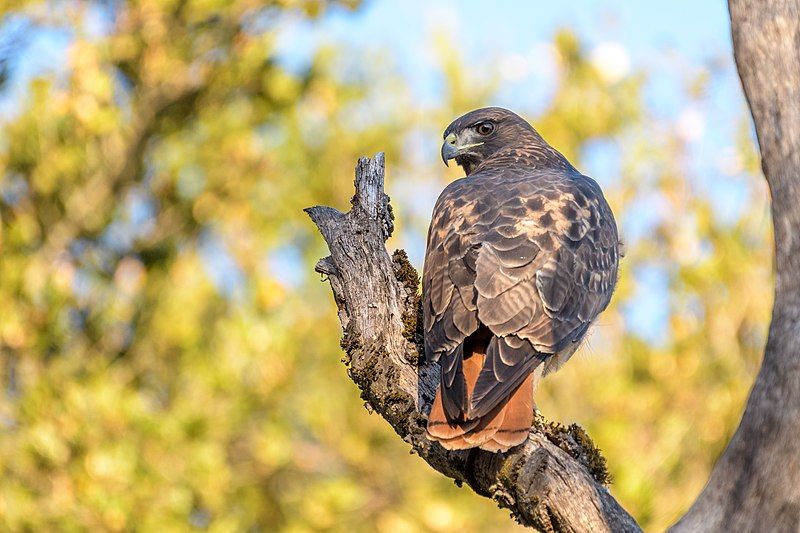
The red-tailed hawk is a type of bird known as a bird of prey. It is found in many different parts of North America. It breeds in various locations, from the interior of Alaska and northern Canada to Panama and the West Indies.
This means you can find red-tailed hawks in many places throughout North America. The red-tailed hawk belongs to a group of birds called the genus Buteo. This genus includes many other species of hawks.
However, the red-tailed hawk is one of the most common members of this group, both in North America and worldwide.
You will likely encounter a red-tailed hawk more often than others within the Buteo genus. The red-tailed hawk is known for its distinctive red tail, which is where it gets its name from.
This feature helps to distinguish it from other types of hawks. However, it is essential to note that not all red-tailed hawks have red tails.
Juvenile red-tailed hawks have brown tails, which only turn red as they mature. Red-tailed hawks are known for their impressive hunting skills.
| Kingdom | Animalia |
| Phylum | Chordata |
| Clade | Dinosauria |
| Class | Aves |
| Order | Accipitriformes |
| Family | Accipitridae |
| Genus | Buteo |
| Species | B. jamaicensis |
16. Mallard
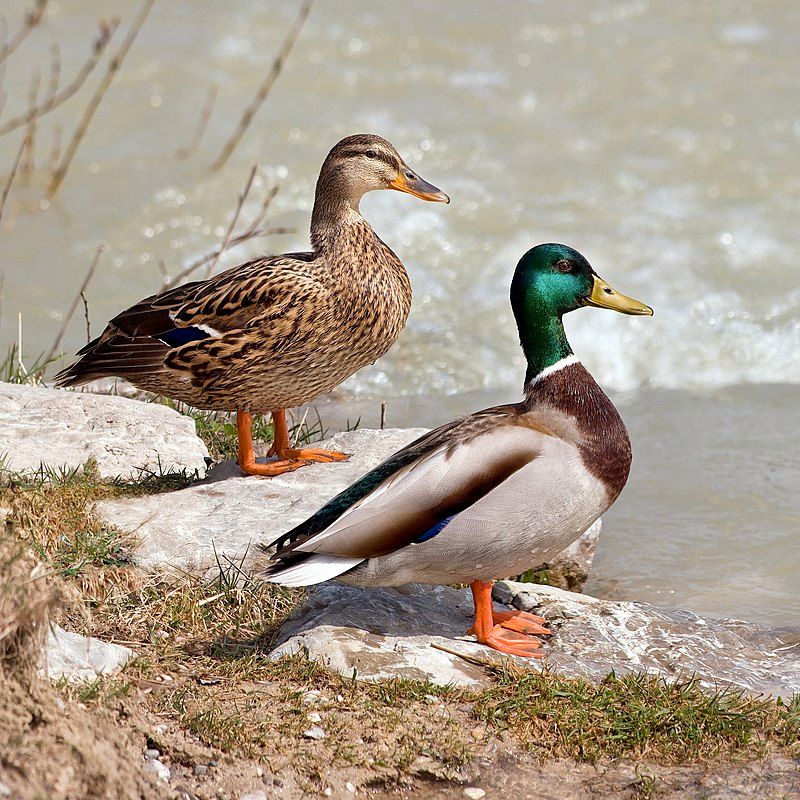
The mallard, also known as the wild duck, is a dabbling duck. It can be found breeding in various world regions, including the temperate and subtropical Americas, Eurasia, and North Africa.
This duck species has been introduced to several countries outside its native range. For example, mallards have been brought to New Zealand, Australia, Peru, Brazil, Uruguay, Argentina, Chile, Colombia, the Falkland Islands, and South Africa.
The mallard’s ability to adapt to different environments has allowed it to thrive in these introduced regions. It is a versatile bird that can adapt to various habitats, such as wetlands, ponds, lakes, and even urban areas. In its native range, the mallard is a migratory bird.
However, in some introduced areas, it has become resident, meaning it stays in one place throughout the year rather than undertaking long-distance migrations.
The mallard is known for its vibrant plumage, with males having a distinctive green head, yellow bill, and brownish body. Conversely, females have a mottled brown appearance, which helps them camouflage with their surroundings. As dabbling ducks, mallards feed.
| Kingdom | Animalia |
| Phylum | Chordata |
| Clade | Dinosauria |
| Class | Aves |
| Order | Anseriformes |
| Family | Anatidae |
| Genus | Anas |
| Species | A. platyrhynchos |
17. Red-Breasted Nuthatch
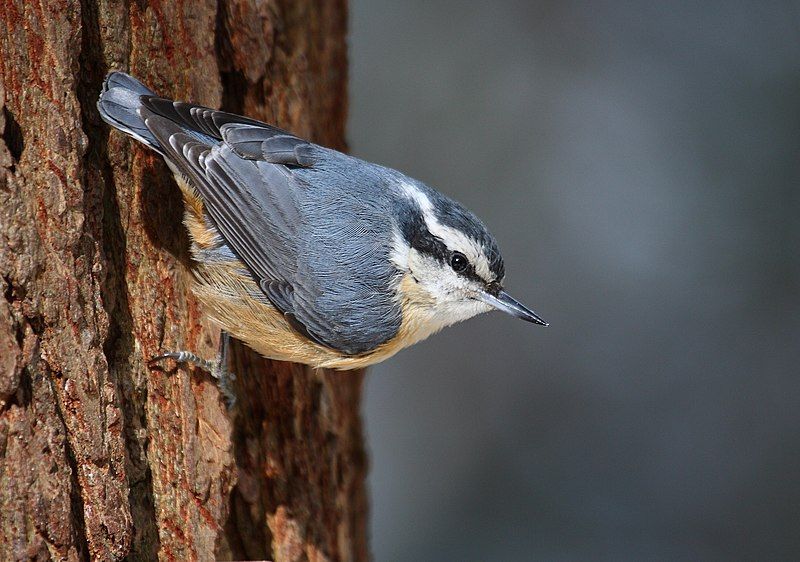
The red-breasted nuthatch is a small bird known for its beautiful appearance and unique characteristics. It has blue-grey feathers on its upper body and cinnamon-colored feathers on its underparts.
This combination of colors creates a striking contrast. Looking closely at the red-breasted nuthatch, you will notice a white throat and face. These white areas provide a stark contrast against the rest of its body.
Additionally, a distinct black stripe runs through its eyes, giving it a charming and distinctive look. Another notable feature of the red-breasted nuthatch is its straight grey bill.
This bill is perfectly shaped for its feeding habits, allowing it to crack open seeds and nuts easily. The bird’s bill is functional and adds to its overall appearance. One of the most striking features of the red-breasted nuthatch is its black crown.
This black area on its head gives the bird a regal and elegant look. Combined with its blue-grey and cinnamon colors, the black crown adds a touch of sophistication to its appearance. Apart from its visual characteristics, the red-breasted nuthatch has a unique call.
Described as a tin trumpet, its call is high-pitched.
| Kingdom | Animalia |
| Phylum | Chordata |
| Clade | Dinosauria |
| Class | Aves |
| Order | Passeriformes |
| Family | Sittidae |
| Genus | Sitta |
| Species | S. canadensis |
18. Common Goldeneye
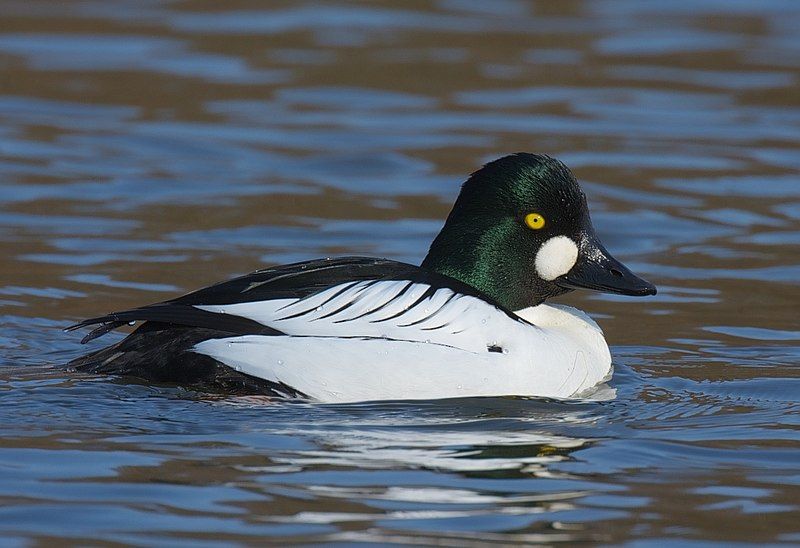
The common goldeneye, also known as goldeneye, is a type of sea duck. It is not too big, but also not too small in size. This particular duck belongs to the genus Bucephala, which includes other types of goldeneyes.
One of its closest relatives is the Barrow’s goldeneye, similar in appearance and characteristics. The genus name “Bucephala” has an interesting origin. It is derived from the Ancient Greek word “boukephalos,” which refers to the shape of the duck’s head.
The head of a goldeneye has a distinctive round shape, resembling a bulbous form. This is similar to the head shape of another duck species called the bufflehead, hence the reference. The common goldeneye is typically found in marine environments.
It prefers to inhabit coastal areas and spends most of its time near the sea. This sea duck has adapted well to its habitat and has developed specific characteristics to thrive. The goldeneye has a unique and attractive appearance.
Its plumage is predominantly black, with a white circular patch on its face. This patch is located just behind the eye, giving the duck a distinct look.
| Kingdom | Animalia |
| Phylum | Chordata |
| Clade | Dinosauria |
| Class | Aves |
| Order | Anseriformes |
| Family | Anatidae |
| Genus | Bucephala |
| Species | B. clangula |
19. Mourning Dove
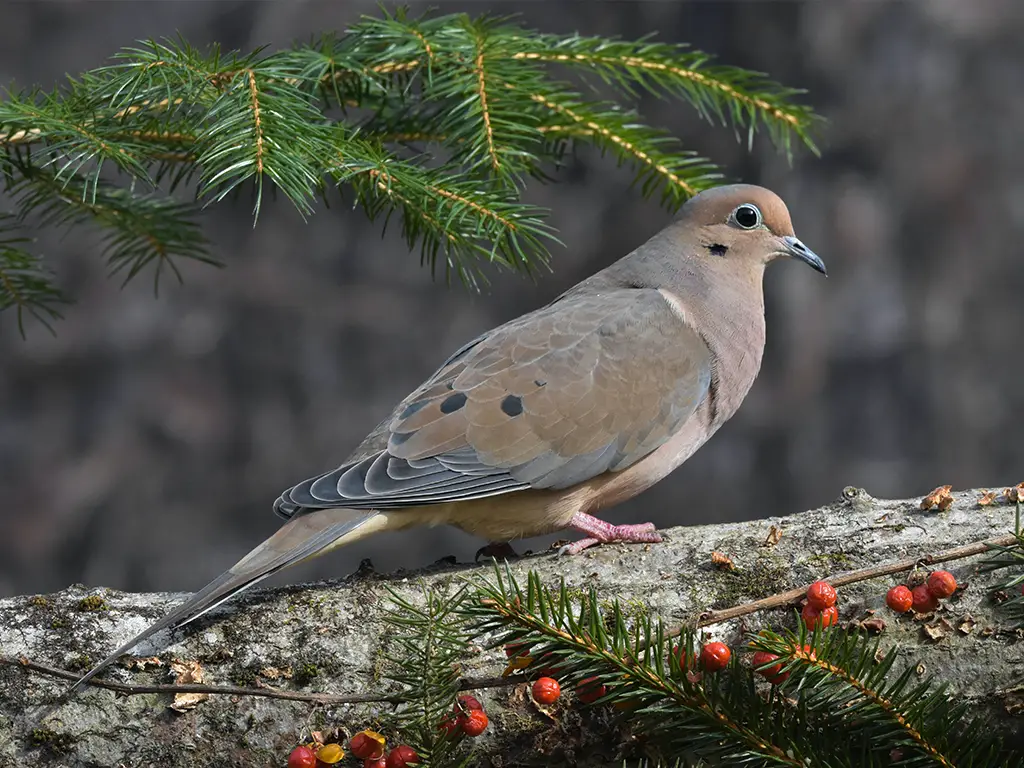
The mourning dove is a type of bird that belongs to the dove family called Columbidae. This bird is also known by different names, such as the American mourning dove, the rain dove, colloquially, and the turtle dove.
In the past, it was referred to as the Carolina pigeon and Carolina turtledove. The mourning dove is a common species found in North and Central America. It is recognized for its soft, mournful cooing sound, which gives it its name.
This bird is known for its slender body and long, pointed tail. It has a grayish-brown color with lighter shades on its underparts. One interesting fact about mourning doves is their ability to adapt to various habitats.
They can be found in different environments like forests, fields, urban areas, and deserts. They are known to thrive in both rural and suburban settings. Mourning doves primarily feed on seeds, grains, and fruits.
They have a unique diet as they can swallow seeds whole and store them in their crop, a specialized part of their digestive system. This allows them to eat in one location and then retreat to a safer place to digest their food. These birds are monogamous, meaning they mate.
| Kingdom | Animalia |
| Phylum | Chordata |
| Clade | Dinosauria |
| Class | Aves |
| Order | Columbiformes |
| Family | Columbidae |
| Genus | Zenaida |
| Species | Z. macroura |
20. Canada Goose
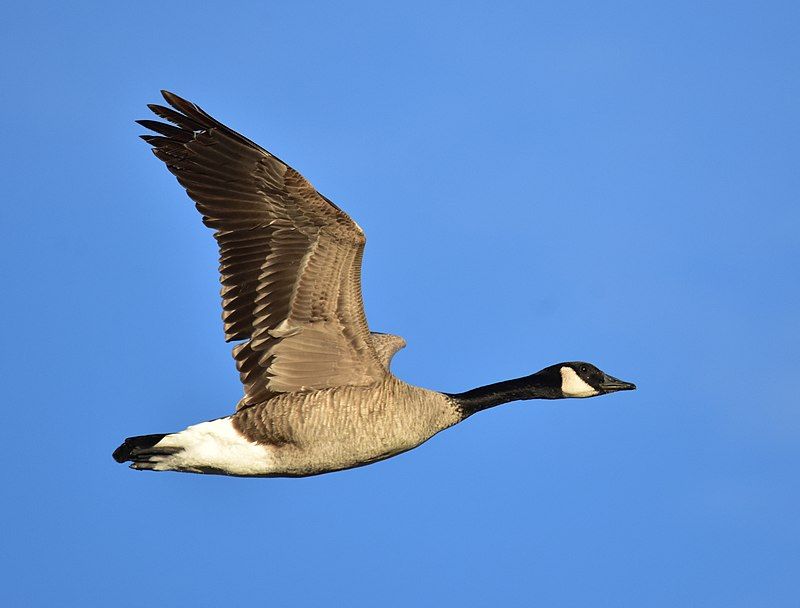
The Canada goose is a type of wild goose that can also be called the Canadian goose. It is pretty significant and has distinct physical features. One of its notable characteristics is a black head and neck.
Additionally, it has white cheeks and a white area under its chin. The body of the Canada goose is typically brown. This goose species is originally from North America’s Arctic and temperate regions. It is well-adapted to these colder climates.
However, during migration, the Canada goose has been known to travel across the Atlantic and can occasionally be found in northern Europe. The Canada goose is a fascinating bird that has captured the attention of many due to its unique appearance.
Its black head and neck contrast sharply against its white cheeks and chin.
This distinctive coloration helps to quickly identify the Canada goose from other species. Native to North America’s arctic and temperate regions, the Canada goose has evolved to survive in harsh environments.
Its adaptations to cold climates include a sturdy build and insulating feathers.
These features enable the goose to endure freezing temperatures and harsh weather conditions. Although primarily found in North America, the Canada goose exhibits exciting behavior during migration.
| Kingdom | Animalia |
| Phylum | Chordata |
| Clade | Dinosauria |
| Class | Aves |
| Order | Anseriformes |
| Family | Anatidae |
| Genus | Branta |
| Species | B. canadensis |
21. Northern Harrier
The northern harrier is a bird of prey commonly found in the northern parts of the northern hemisphere. Other names, such as the marsh hawk or ring-tailed hawk, also know it.
This bird is known for its exceptional hunting skills and distinctive appearance. Breeding is a significant part of the northern harrier’s life cycle. It prefers to breed in the regions of the north of Canada and the northernmost parts of the United States.
These areas provide suitable habitats for the bird’s nesting and breeding activities. The northern harrier’s habitat mainly consists of marshes, wetlands, and open fields.
These environments offer an abundance of prey, including small mammals and birds, which the harrier hunts for food.
Its hunting technique is unique as it relies on low, slow flight and uses its keen sense of hearing and sight to locate and capture its prey. One remarkable characteristic of the northern harrier is its distinctive appearance.
It has long, narrow wings allow it to maneuver swiftly through the air. Its tail is also long and distinctive, resembling a ring.
This feature is why it is sometimes referred to as the ring-tailed hawk. The northern harrier is a medium-sized bird, with males usually slightly smaller than females.
| Kingdom | Animalia |
| Phylum | Chordata |
| Clade | Dinosauria |
| Class | Aves |
| Order | Accipitriformes |
| Family | Accipitridae |
| Genus | Circus |
| Species | C. hudsonius |
22. American Kestrel
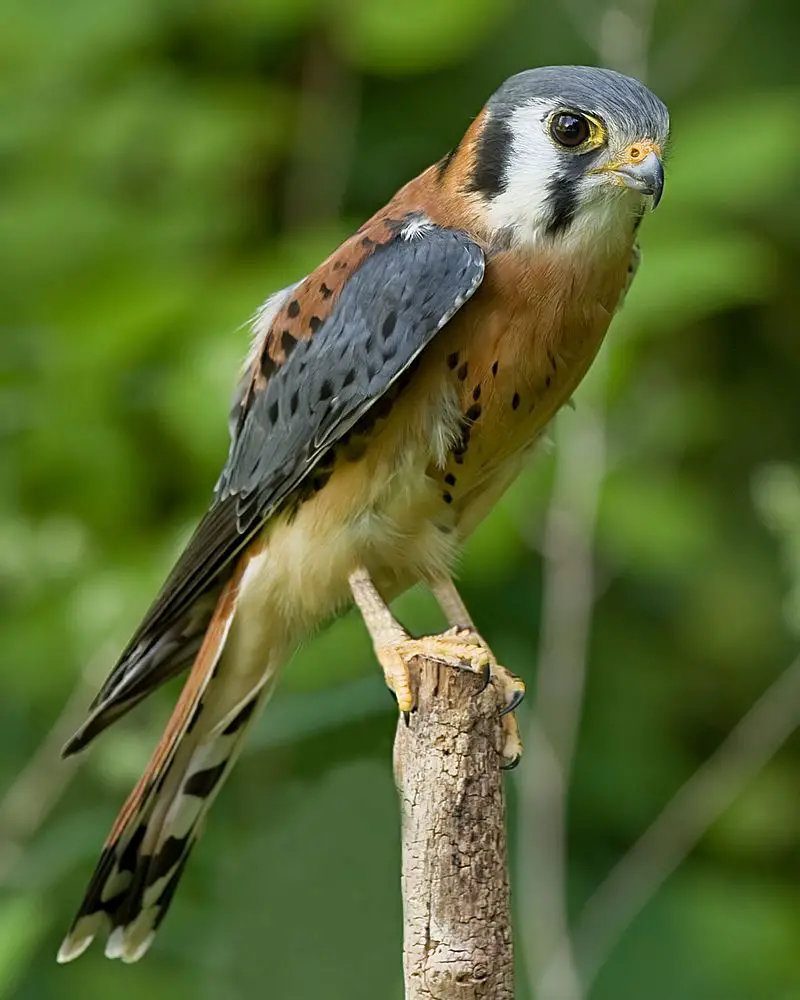
The American kestrel is a type of falcon that can also be known as the sparrow hawk. It is found in North America and is the region’s smallest and most common falcon. The size of the American kestrel can vary depending on the subspecies and the sex of the bird.
Generally, there is a two-to-one range in size between different individuals. When it comes to size, the American kestrel can range from being as small as a blue jay to as large as a mourning dove.
This means some individuals can weigh as much as a blue jay, while others can be as heavy as a mourning dove. The variation in size within the American kestrel population can be attributed to differences in subspecies and between males and females.
This means that females may generally be more significant than males, and different subspecies may have different average sizes. Interestingly, despite this size variation, the American kestrel remains the smallest falcon in North America.
This indicates that even the most prominent individuals of this species are still relatively small compared to other falcons in the region. In conclusion, the American kestrel is also known as the sparrow.
| Kingdom | Animalia |
| Phylum | Chordata |
| Clade | Dinosauria |
| Class | Aves |
| Order | Falconiformes |
| Family | Falconidae |
| Genus | Falco |
| Species | F. sparverius |
23. Ruby-Crowned Kinglet
The ruby-crowned kinglet is a small bird found all over North America. It belongs to the kinglet family, which includes other small bird species. This bird has olive-green feathers that cover its body.
Additionally, it has two white bars on its wings and a white ring around its eye. If we look closely, we can notice some differences between males and females of the species. The male ruby-crowned kinglet has a unique feature on its head – a red patch on its crown.
However, this patch is not always visible as it is often hidden. On the other hand, female ruby-crowned kinglets do not have this red crown patch. Despite their small size, these birds are known for their energetic and active behavior.
They are constantly flying and hopping from branch to branch for food. Ruby-crowned kinglets feed on insects, spiders, and small invertebrates in trees and shrubs. One interesting fact about these birds is that they are known to be quite vocal.
They produce a variety of sounds to communicate with each other. Their songs consist of high-pitched and rapid notes, which can be quite melodic and pleasant to hear. During the breeding season, male ruby-crowned.
| Kingdom | Animalia |
| Phylum | Chordata |
| Clade | Dinosauria |
| Class | Aves |
| Order | Passeriformes |
| Family | Regulidae |
| Genus | Corthylio |
| Species | C. calendula |
24. Mountain Chickadee
The mountain chickadee is a type of bird that is known for its small size. It belongs to the passerine bird family, which means it is a perching bird with three toes pointing forward and one toe pointing backward.
This family is also known as the tit family and is scientifically referred to as Paridae. Being a passerine bird, the mountain chickadee has a unique anatomy that allows it to perch on branches or other surfaces.
It has specialized feet with sharp claws help it grip onto branches securely.
This adaptation enables the bird to move around its habitat, including trees and bushes while foraging for food or searching for a suitable nesting site. The mountain chickadee is not only recognized for its small size but also for its melodious song.
It has a beautiful and distinctive call that it uses to communicate with other birds of its species.
This song is often heard during the breeding season when the males try to attract females or establish their territory. In terms of physical appearance, the mountain chickadee has a black cap on its head that extends down its throat, making it easily distinguishable.
It also has a grayish body with white patches on its wings and sides.
| Kingdom | Animalia |
| Phylum | Chordata |
| Clade | Dinosauria |
| Class | Aves |
| Order | Passeriformes |
| Family | Paridae |
| Genus | Poecile |
| Species | P. gambeli |
25. Rough-Legged Buzzard
The rough-legged buzzard, also known as the rough-legged hawk, is a bird of prey that is medium-large in size. It can be found in the Arctic and Subarctic regions of North America, Europe, and Russia. During the breeding season, these buzzards make their home in these regions.
However, when winter arrives, they migrate south. These birds are well-suited to survive in the harsh Arctic and Subarctic climates. They have adapted to the cold weather and snowy landscapes of these regions.
The rough-legged buzzard has several physical characteristics that help it thrive in these environments. One of the distinctive features of the rough-legged buzzard is its feathered legs.
These feathers extend down to its feet, providing insulation against the cold temperatures.
This adaptation allows the bird to maintain its body heat and prevents frostbite. The rough-legged buzzard also has a large wingspan, which helps it soar through the air effortlessly. This enables the bird to cover long distances during migration and efficiently search for prey.
Their broad and rounded wings make them well-suited for gliding and hovering. Regarding hunting, the rough-legged buzzard primarily feeds on small mammals, such as rodents.
| Kingdom | Animalia |
| Phylum | Chordata |
| Clade | Dinosauria |
| Class | Aves |
| Order | Accipitriformes |
| Family | Accipitridae |
| Genus | Buteo |
| Species | B. lagopus |
26. Cooper’s Hawk
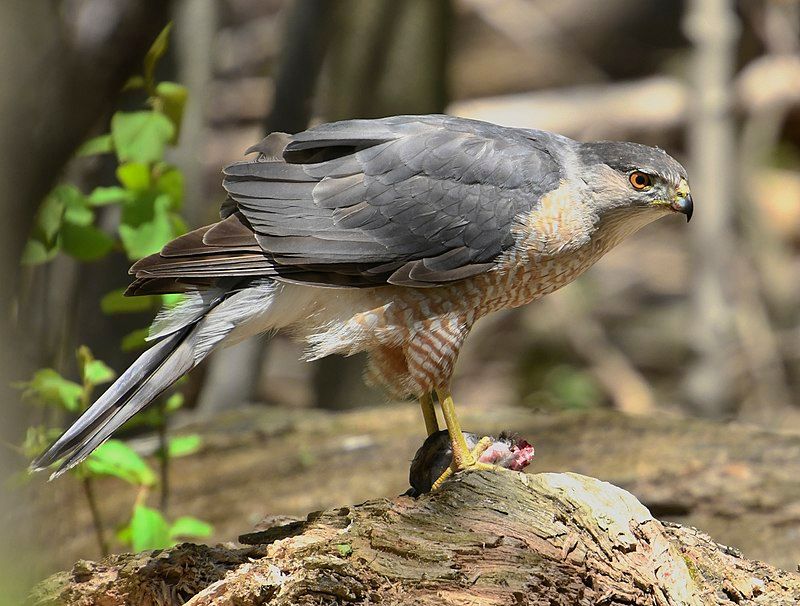
The Cooper’s hawk is a type of hawk found in North America. It is considered to be a medium-sized bird.
This species is native to the continent and commonly found in various regions ranging from southern Canada to Mexico. One attractive characteristic of the Cooper’s hawk is its size.
It falls into the category of medium-sized hawks, which means it is neither too big nor too small. This size allows the hawk to adapt and survive in different habitats across North America. The distribution of the Cooper’s hawk is quite extensive.
It can be found in North America, including southern Canada, the United States, and Mexico.
This wide range of habitats gives the hawk ample opportunities to thrive and establish its presence in various ecosystems. Despite its widespread distribution, the Cooper’s hawk is not evenly distributed throughout its range.
It tends to be more common in certain areas and less abundant in others. This variation in population density might be influenced by factors such as the availability of prey, nesting sites, and overall habitat suitability. The Cooper’s hawk is known for its hunting skills.
It primarily feeds on small to medium-sized birds, which it catches by surprise with speed and agility. This hawk is well-adapted.
| Kingdom | Animalia |
| Phylum | Chordata |
| Clade | Dinosauria |
| Class | Aves |
| Order | Accipitriformes |
| Family | Accipitridae |
| Genus | Accipiter |
| Species | A. cooperii |
27. American Coot
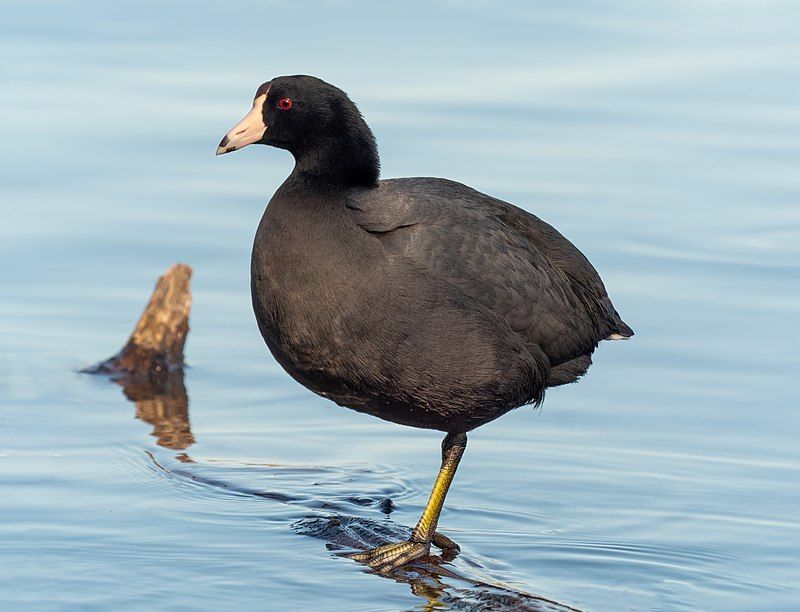
The American coot is a bird that is often confused with ducks. However, it belongs to a different family called Rallidae. This means that coots and ducks are not closely related despite some similarities. Coots are sometimes referred to as mud hens or rouleau.
These names highlight their preference for watery habitats, such as marshes, ponds, and lakeshores. They are well-adapted to living in these environments. Unlike ducks, coots have a distinct body shape. They have a plump body, short tail, and a chicken-like beak.
This unique appearance helps to differentiate them from ducks. Regarding their behavior, coots are known for their strong swimming abilities. They have lobed toes, which are not webbed like ducks but have flaps of skin that aid in propulsion through the water.
This allows them to navigate through the water with ease. Another interesting fact about coots is that they are primarily herbivorous. They feed on aquatic plants, algae, and sometimes even insects.
Their diet is well-suited to their habitat, as they can often find abundant plant material in the shallow waters they inhabit. Coots are high.
| Kingdom | Animalia |
| Phylum | Chordata |
| Clade | Dinosauria |
| Class | Aves |
| Order | Gruiformes |
| Family | Rallidae |
| Genus | Fulica |
| Species | F. americana |
28. California Scrub Jay
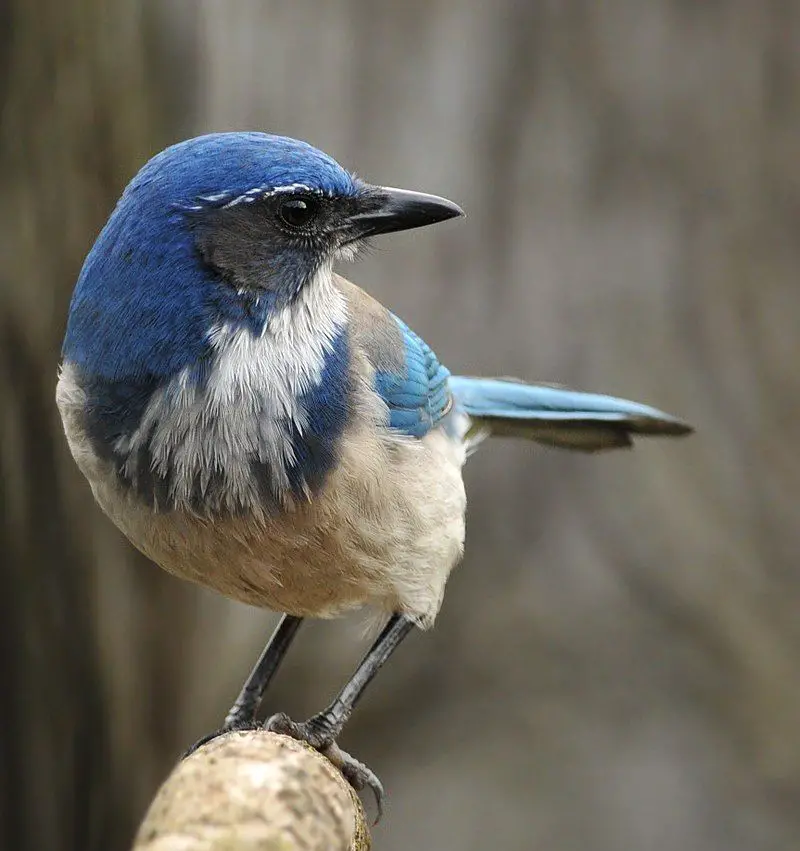
The California scrub jay is a type of bird called a scrub jay. It is found in western North America. This bird species can be seen in many places, such as southern British Columbia, California, and west Nevada near Reno.
The California scrub jay also lives in areas on the western side of the Sierra Nevada mountain range. This bird is specifically known as the California scrub jay because it is native to California.
It is well adapted to the habitat and environment found in this region.
The California scrub jay has specific characteristics and behaviors that help it survive and thrive in its natural surroundings. The range of the California scrub jay extends from southern British Columbia to western Nevada.
This means that this bird can be found in a wide geographic area. It covers a large portion of the western part of North America.
The California scrub jay can inhabit various habitats within this range, such as forests, woodlands, and gardens. One interesting fact about the California scrub jay is that it is a member of the corvid family, which includes other intelligent birds like crows and ravens.
The California scrub jay is known for its cleverness and problem-solving abilities. It has been observed.
| Kingdom | Animalia |
| Phylum | Chordata |
| Clade | Dinosauria |
| Class | Aves |
| Order | Passeriformes |
| Family | Corvidae |
| Genus | Aphelocoma |
| Species | A. californica |
29. Brown-Headed Cowbird
The brown-headed cowbird is a bird species found in temperate and subtropical regions of North America. It is known for its behavior as a brood parasite, meaning it lays its eggs in the nests of other bird species.
This behavior is obligatory for the brown-headed cowbird, which means it relies on other birds to raise its young. The brown-headed cowbird is a small bird with a brown head and dark body.
It is commonly found in the southern parts of its range throughout the year, where it remains a permanent resident.
However, the birds from the northern regions migrate to the southern United States and Mexico during the winter season.
The migration of the northern brown-headed cowbirds occurs because the colder conditions in their northern habitats make it challenging to find sufficient food during the winter months.
Traveling to the southern regions, where the climate is milder and food resources are more abundant, increases their chances of survival. The migration typically takes place in a southward direction, starting around the onset of winter.
These birds undertake a long journey, often flying miles to reach their wintering grounds. They remain in these warmer regions until spring, around March or April, after winter.
| Kingdom | Animalia |
| Phylum | Chordata |
| Clade | Dinosauria |
| Class | Aves |
| Order | Passeriformes |
| Family | Icteridae |
| Genus | Molothrus |
| Species | M. ater |
30. Pine Siskin
The pine siskin is a type of bird found in North America. It belongs to the finch family, which includes other small birds like sparrows and goldfinches.
The pine siskin is known for its ability to migrate, meaning it travels from one place to another depending on the season. During the winter, the pine siskin’s range becomes very unpredictable.
It moves around sporadically instead of following a specific pattern or staying in one place.
Predicting where precisely these birds will be during the winter months can be challenging. The reason behind the pine siskin’s sporadic winter range is not entirely understood.
It is believed that factors like food availability and weather conditions play a role in determining their movements.
When specific food sources become scarce in one area, the birds may move to another location in search of better resources. The pine siskin’s winter range can vary from year to year.
One winter, they might be seen in large numbers in a particular region, while the following winter, they may be scarce or absent from the same area.
This unpredictability adds to the bird’s unique characteristics and makes it an interesting species to study. Researchers and bird enthusiasts often.
| Kingdom | Animalia |
| Phylum | Chordata |
| Clade | Dinosauria |
| Class | Aves |
| Order | Passeriformes |
| Family | Fringillidae |
| Genus | Spinus |
| Species | S. pinus |
31. Cassin’s Finch
Cassin’s finch is a type of bird that belongs to the finch family known as Fringillidae.
It is a species that falls under the genus Haemorhous and other birds known as “American rosefinches.”The finch family Fringillidae is a group of small to medium-sized birds known for their cone-shaped beaks.
They are found in various parts of the world, including North America, Europe, Africa, and Asia. Cassin’s finch is native to the western parts of North America, including regions such as the Rocky Mountains and the Sierra Nevada.
It is known for its vibrant plumage, with males displaying a reddish-pink color on their head and breast, while females have a more subdued brownish-gray appearance.
The genus Haemorhous includes several species of finches that are commonly referred to as “American rosefinches.” These birds are closely related to each other and share similar characteristics.
They are often found in forested areas, mountains, and shrubby habitats. One notable feature of the American rosefinches is their adaptability to different environments. They can be found in a range of habitats.
| Kingdom | Animalia |
| Phylum | Chordata |
| Clade | Dinosauria |
| Class | Aves |
| Order | Passeriformes |
| Family | Fringillidae |
| Genus | Haemorhous |
| Species | H. cassinii |
32. California Quail
The California quail is a type of bird that lives on the ground. It is also sometimes called the California Valley quail or Valley quail. These birds belong to the New World quail family. One exciting feature of the California quail is its crest or plume.
This is a curved bunch of feathers on top of its head. The crest is made up of six feathers. In male quails, the crest is black. However, in female quails, the crest is brown. Another distinctive characteristic of the California quail is its appearance.
The birds have brown flanks, which are the sides of their bodies. On these flanks, there are white streaks.
These streaks create a pattern on the bird’s feathers, making it look unique. The California quail is a ground-dwelling bird, which means it spends most of its time on the ground rather than flying.
This bird is usually found in the western parts of the United States, particularly in California. It prefers habitats such as grasslands, foothills, and agricultural areas. These quails are social birds and often live in groups called coveys.
Coveys can consist of a few birds or even up to.
| Kingdom | Animalia |
| Phylum | Chordata |
| Clade | Dinosauria |
| Class | Aves |
| Order | Galliformes |
| Family | Odontophoridae |
| Genus | Callipepla |
| Species | C. californica |
33. Blue Jay
The blue jay is a bird that belongs to the family Corvidae. It can be found in eastern North America. This bird is commonly found in many eastern and central United States parts.
However, it is essential to note that some blue jays in the eastern regions may migrate to other areas. In addition to the United States, blue jays reside in Newfoundland, Canada. They are considered residents in this area.
Breeding populations of blue jays can be observed across southern Canada. This means that these birds reproduce and raise their young in this region. The blue jay is a passerine bird, meaning it has specialized feet that allow it to perch on tree branches.
It is native to eastern North America and can be found in various parts of the United States, Newfoundland, and southern Canada.
| Kingdom | Animalia |
| Phylum | Chordata |
| Clade | Dinosauria |
| Class | Aves |
| Order | Passeriformes |
| Family | Corvidae |
| Genus | Cyanocitta |
| Species | C. cristata |
34. White-Breasted Nuthatch
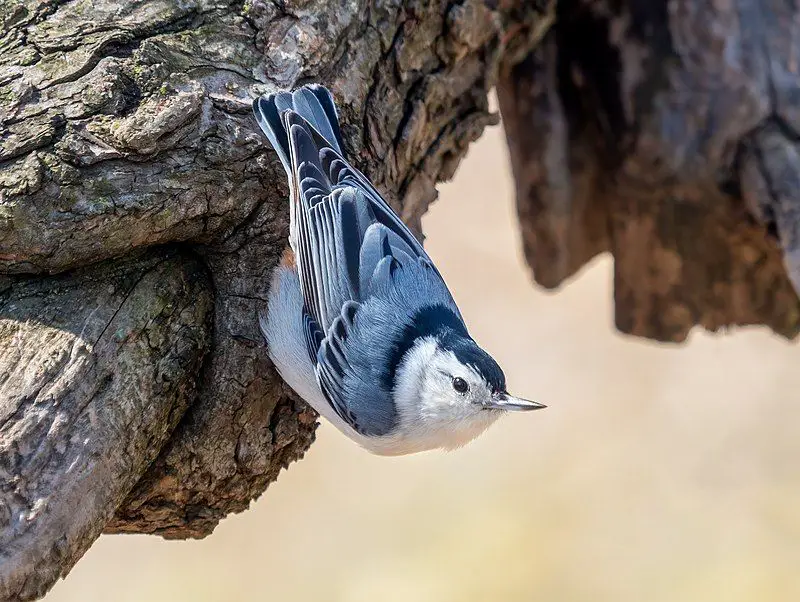
The white-breasted nuthatch is a type of bird that belongs to the nuthatch family called Sittidae.
This family includes various species of nuthatches, but we will focus on the white-breasted nuthatch in this discussion. The white-breasted nuthatch is a medium-sized bird, measuring around 15.5 cm long.
This measurement gives us an idea of its size compared to other birds. While it may not be the most significant bird out there, it is also not the smallest. One exciting feature of the white-breasted nuthatch is its white breast, which gives it its name.
This white coloration on its chest stands out and helps to identify it from other species of nuthatches.
It is worth noting that not all nuthatches have this specific feature, making it unique to the white-breasted nuthatch. As a nuthatch family member, the white-breasted nuthatch shares particular characteristics with other nuthatch species.
For example, nuthatches are known for their ability to climb up and down trees headfirst. This behavior is quite fascinating to observe, as most birds can only move in an upward direction. In addition.
| Kingdom | Animalia |
| Phylum | Chordata |
| Clade | Dinosauria |
| Class | Aves |
| Order | Passeriformes |
| Family | Sittidae |
| Genus | Sitta |
| Species | S. carolinensis |
35. Great Horned Owl
The great horned owl is a species of owl found in the Americas. Other names, such as the tiger owl and the hoot owl, also know it.
This owl is known for its adaptability and can be found in various habitats across its wide range. Being a large owl, the great horned owl has a distinct appearance. It has prominent ear tufts on its head, which give it a horned appearance.
This characteristic distinguishes it from other owl species. One of the remarkable traits of the great horned owl is its adaptability. It can be found in many habitats, including forests, deserts, mountains, and urban areas.
This versatility allows the owl to thrive in diverse environments, making it the most widely distributed true owl in the Americas. The great horned owl is a skilled hunter, preying on various animals. Its diet includes small mammals like rabbits, mice, and rats.
Additionally, it feeds on birds, reptiles, amphibians, and even other owls. This owl species has excellent hunting abilities. It possesses sharp talons and a powerful beak, which it uses to catch and kill its prey.
Its wings are designed for silent flight, allowing it to approach.
| Kingdom | Animalia |
| Phylum | Chordata |
| Clade | Dinosauria |
| Class | Aves |
| Order | Strigiformes |
| Family | Strigidae |
| Genus | Bubo |
| Species | B. virginianus |
36. Black-Chinned Hummingbird
The black-chinned hummingbird is a type of hummingbird that can be found in many different kinds of environments. It can adapt and live in a wide range of habitats.
During the summer, the black-chinned hummingbird can be found in the western part of the United States and southwestern Canada. This is where they spend their breeding season, building nests and raising their young.
However, when the colder weather arrives, the black-chinned hummingbird is a migratory bird. It travels to warmer areas for the winter season. Some of these birds fly as far south as Mexico to find a more suitable climate during the winter months.
One attractive characteristic of the black-chinned hummingbird is its gorget. The gorget is a patch of feathers located on the bird’s throat area.
These feathers have an iridescent purple color, which means they can appear to change color depending on the angle the light hits them. The gorget of the black-chinned hummingbird is particularly striking when the bird is in direct sunlight.
The purple feathers stand out against the black feathers on the bird’s chin, creating a beautiful contrast. This is one of the ways that the black-chinned hummingbird.
| Kingdom | Animalia |
| Phylum | Chordata |
| Clade | A. Alexandria |
| Class | Aves |
| Order | Apodiformes |
| Family | Trochilidae |
| Genus | Archilochus |
| Species | A. alexandri |
37. Ring-Billed Gull
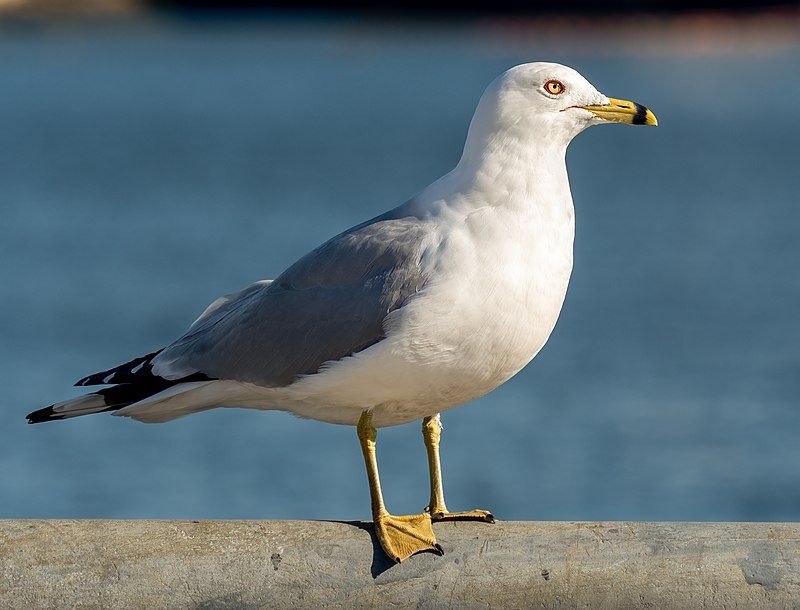
The ring-billed gull is a medium-sized gull. The term “ring-billed” comes from the distinctive ring-like band around its beak. This gull belongs to a group of birds known as Larus, the genus name.
“Larus” is derived from Latin and seems to have been used to describe gulls or other large seabirds. The genus Larus is a way to categorize and classify different species of gulls.
It helps scientists and bird enthusiasts understand the relationships and similarities between these birds.
Using the genus, Larus makes it easier to identify and study gulls systematically. The specific name of this particular gull, delawarensis, refers to the Delaware River.
This means the ring-billed gull is associated with or found near the Delaware River.
It is named after this specific location, which may be a significant habitat for this species. The naming of species often involves using specific names that indicate a particular geographic location or characteristic of the species.
In the case of the ring-billed gull, the term delawarensis is used to highlight its connection to the Delaware River.
| Kingdom | Animalia |
| Phylum | Chordata |
| Clade | Dinosauria |
| Class | Aves |
| Order | Charadriiformes |
| Family | Laridae |
| Genus | Larus |
| Species | L. delawarensis |
38. Northern Pintail
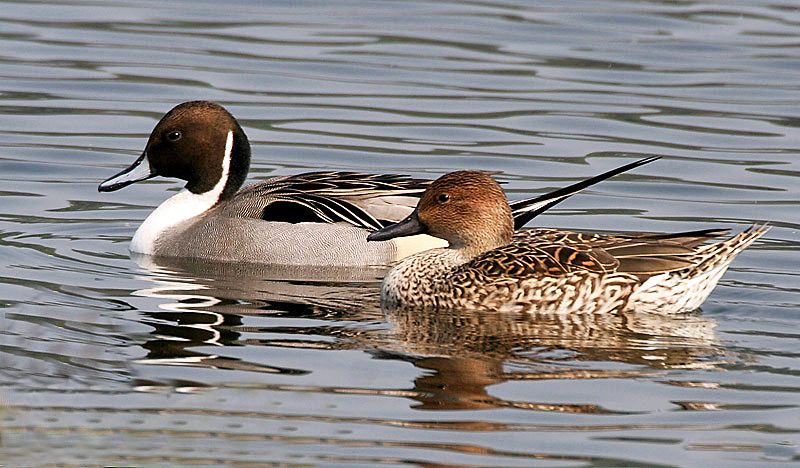
The pintail, also known as the northern pintail, is a type of duck found in various parts of the world. It has a wide geographic distribution and is known to breed in the northern regions of Europe and across the Palearctic and North America.
One interesting fact about the pintail is that it is a migratory bird. This means it travels from one place to another, depending on the season. During the winter, the pintail moves south from its breeding areas.
It can be found as far as the equator during this time. This migration pattern helps the pintail find suitable habitats and resources throughout the year. The pintail’s migration is primarily related to food availability and climate conditions.
As winter approaches and the temperatures drop in the northern areas where it breeds, the pintail needs to find a more hospitable environment.
By moving south, it can escape the harsh winter conditions and find areas with milder weather and abundant food sources.
During the breeding season, the pintail prefers to nest in wetland areas, such as marshes, ponds, and lakes in northern Europe and North America.
These wetlands provide the necessary resources.
| Kingdom | Animalia |
| Phylum | Chordata |
| Clade | Dinosauria |
| Class | Aves |
| Order | Anseriformes |
| Family | Anatidae |
| Genus | Anas |
| Species | A. acuta |
39. Barn Swallow
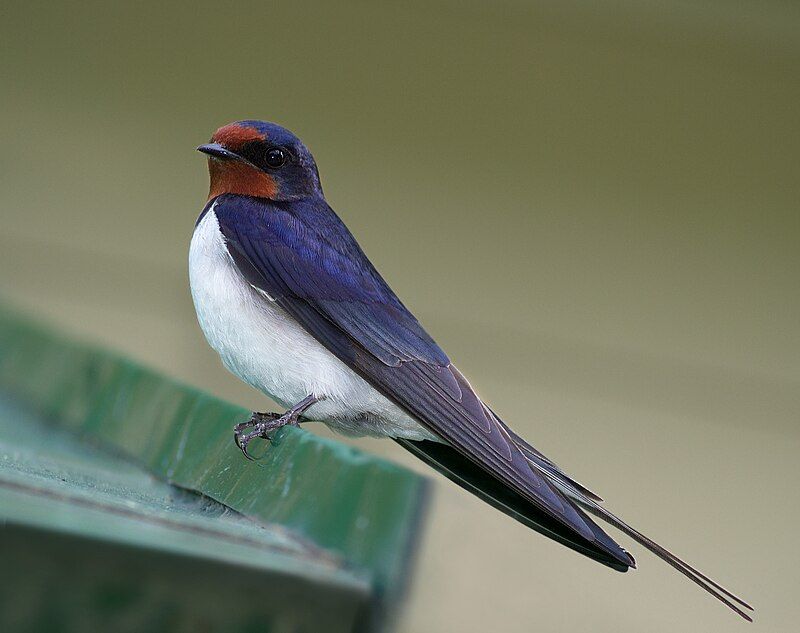
The barn swallow is a type of bird that can be found worldwide. It is the most common species of swallow.
This means there are more barn swallows than any other type of swallow in the world. What is interesting about the barn swallow is that it can be found in many different places. It has the most extensive natural distribution of any passerine bird.
Passerine birds are a type of bird that includes sparrows, finches, and swallows. This means the barn swallow can be found in more areas than any other type of passerine bird. The barn swallow’s range covers over 251 million square kilometers worldwide.
That is a vast area! To put it into perspective, that’s about the same size as the entire continent of Europe.
So, no matter where you go, there is a good chance that you will spot a barn swallow. The barn swallow is easily recognizable due to its distinctive appearance. It has blue upperparts, meaning its back and wings are blue.
This blue color is quite vibrant and stands out against the sky. It also has a long, deeply forked tail. This means that its tail is split into two distinct points.
| Kingdom | Animalia |
| Phylum | Chordata |
| Clade | Dinosauria |
| Class | Aves |
| Order | Passeriformes |
| Family | Hirundinidae |
| Genus | Hirundo |
| Species | H. rustica |
40. Steller’s Jay
The Steller’s jay is a type of bird found in western North America and the mountains of Central America. It is closely related to another bird called the blue jay, commonly found in eastern North America.
However, the Steller’s jay is the only jay with a crest that can be found west of the Rocky Mountains. The Steller’s jay is known for its striking appearance. It has a deep blue plumage with black markings on its head, wings, and tail.
One of its most distinctive features is its crest, a collection of feathers on top of its head that can be raised or lowered depending on its mood or level of excitement. Regarding habitat, the Steller’s jay prefers forests and woodlands, especially those with coniferous trees.
It is often seen perched on tree branches or hopping around on the forest floor, searching for food.
These birds are pretty agile and are known for their ability to fly quickly and maneuver through dense vegetation. Steller’s jays are omnivores, meaning they eat a variety of foods.
Their diet includes insects, nuts, seeds, berries, and even small vertebrates like lizards or birds.
| Kingdom | Animalia |
| Phylum | Chordata |
| Clade | Dinosauria |
| Class | Aves |
| Order | Passeriformes |
| Family | Corvidae |
| Genus | Cyanocitta |
| Species | C. stelleri |
41. Great Blue Heron
The great blue heron is a bird from the heron family called Ardeidae. It is a big bird that is often seen wading in water. You can find it near the shores of open water and in wetlands in many parts of North and Central America.
It is also found in far northwestern South America, the Caribbean, and even the Galápagos Islands. These herons are known for their tall and slender bodies, long legs, and a long neck.
They have a distinctive blue-gray coloration on their feathers, which gives them their name.
They also have a large, dagger-like beak to catch their prey. You can often spot great blue herons standing still in shallow water, patiently waiting for fish or other small animals to come by.
They are excellent hunters and have sharp eyesight, which helps them spot their prey from a distance.
Once they see a potential meal, they use their long necks to strike quickly and snatch it up with their beaks. While they primarily feed on fish, these herons are also known to eat amphibians, reptiles, and even small mammals.
Their diet depends on what is available in their habitat. They are adaptable.
| Kingdom | Animalia |
| Phylum | Chordata |
| Clade | Dinosauria |
| Class | Aves |
| Order | Pelecaniformes |
| Family | Ardeidae |
| Genus | Ardea |
| Species | A. herodias |
42. Cedar Waxwing
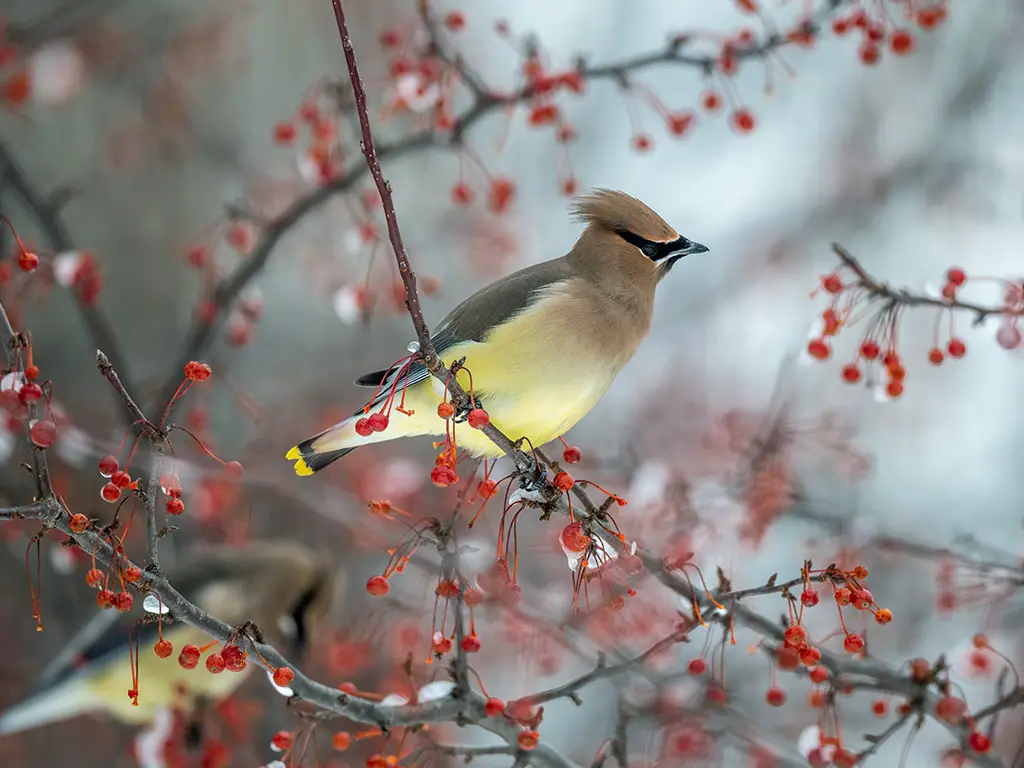
The cedar waxwing is a type of bird that belongs to the waxwing family of passerine birds known as Bombycillidae. Passerine birds are perching birds, which means they have feet adapted for gripping branches.
The cedar waxwing is a medium-sized bird with a distinctive appearance. Its feathers are mostly brown, gray, and yellow.
These colors help the bird blend well with its surroundings, making it harder for predators to spot it. One of the most unique features of the cedar waxwing is its wings. The bird gets its name from the wax-like tips on its wings.
These wing tips look like they have been dipped in wax, giving the bird a fascinating and memorable look. The wax-like wing tips serve a purpose for the cedar waxwing. They are specialized feathers that help the bird in various ways.
The waxy substance on the wing tips repels water, allowing the bird to fly more easily in wet weather conditions. It also helps the bird glide smoothly, reducing air resistance. Another exciting aspect of the cedar waxwing is its diet.
This bird primarily feeds on fruits, such as berries, and small fruits, like cherries. It has a unique adaptation in it.
| Kingdom | Animalia |
| Phylum | Chordata |
| Clade | Dinosauria |
| Class | Aves |
| Order | Passeriformes |
| Family | Bombycillidae |
| Genus | Bombycilla |
| Species | B. cedrorum |
43. Brown Creeper
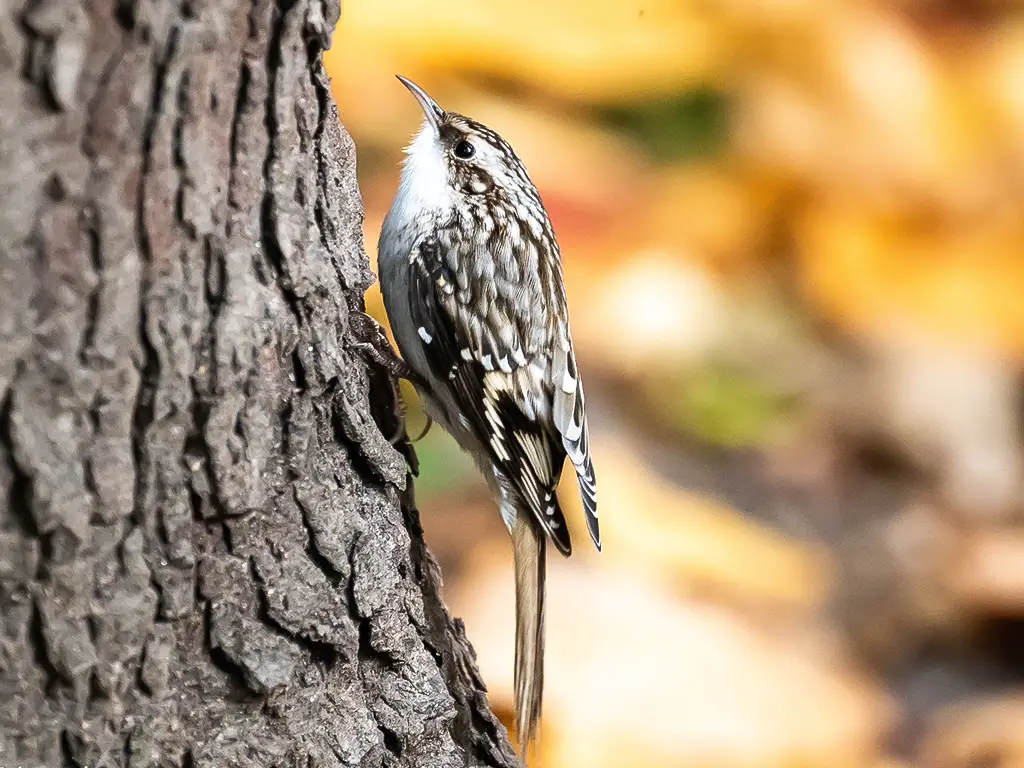
The brown creeper is a small bird called the American treecreeper. It belongs to the treecreeper family called Certhiidae.
This bird is found only in North America, making it the only member of its family in this region. The brown creeper is known for its unique behavior of climbing up tree trunks. It has a curved bill that helps it search for insects and spiders residing in the bark of trees.
The bird uses its stiff tail feathers as a support while spiraling up the trees in a spiral pattern. The brown creeper has a distinct appearance. It has brown feathers that blend well with the bark of trees, providing camouflage and making it difficult to spot.
The bird has a white underbelly with streaks of brown, which helps it blend in with the tree trunks. This small songbird measures about 12-14 centimeters in length and weighs around 9-14 grams. It has a wingspan of approximately 18-20 centimeters.
The brown creeper’s body is slender, allowing it to maneuver easily among trees. These birds are primarily found in mature forests with a dense canopy. They prefer habitats with a mix of deciduous and coniferous.
| Kingdom | Animalia |
| Phylum | Chordata |
| Clade | Dinosauria |
| Class | Aves |
| Order | Passeriformes |
| Family | Certhiidae |
| Genus | Certhia |
| Species | C. americana |
44. American Three-Toed Woodpecker
The American three-toed woodpecker is a bird found in North America. It is classified as a medium-sized woodpecker species.
This particular woodpecker is native to the region, meaning it is naturally found there and not introduced from elsewhere. Being medium-sized, the American three-toed woodpecker falls within a specific size range compared to other woodpecker species.
This size classification helps distinguish it from smaller or larger woodpeckers.
It is important to note that medium-sized is a relative term, as there may be variations in size among individuals within the species. The American three-toed woodpecker has adapted to its environment in North America.
It possesses three toes, a unique characteristic distinguishing it from other woodpecker species that typically have four toes.
Reducing the number of toes is an evolutionary adaptation that aids the bird’s ability to cling to tree trunks and obtain food. As a native species, the American three-toed woodpecker has likely evolved to thrive in its specific habitat within North America.
It has adapted its behaviors, feeding habits, and physical characteristics to suit its environment, allowing it to find food and survive successfully in the wild.
| Kingdom | Animalia |
| Phylum | Chordata |
| Clade | Dinosauria |
| Class | Aves |
| Order | Piciformes |
| Family | Picidae |
| Genus | Picoides |
| Species | P. dorsalis |
45. Merlin

The merlin is a type of falcon that can be found in various parts of the Northern Hemisphere. It is known for its small size compared to other falcon species.
The merlin has several subspecies in different regions of North America and Eurasia. These falcons are widely distributed across their habitat range and can be found in diverse environments. They can be seen in forests, grasslands, and even urban areas.
The ability of the merlin to adapt to various habitats contributes to its widespread presence. In North America, the merlin has different subspecies found in distinct regions.
For example, there is the prairie merlin, primarily found in the central grasslands of the continent. On the other hand, the taiga merlin inhabits the boreal forests of Canada and Alaska. In Eurasia, the merlin also has varied subspecies.
They can be found in countries like Russia, Norway, and Sweden, among others. Each subspecies may have specific adaptations and characteristics that suit their particular environment. The Merlin falcon is known for its agility and speed.
It is a skilled hunter capable of catching swift-flying prey such as small birds and insects.
| Kingdom | Animalia |
| Phylum | Chordata |
| Clade | Dinosauria |
| Class | Aves |
| Order | Falconiformes |
| Family | Falconidae |
| Genus | Falco |
| Species | F. columbarius |
46. American Crow
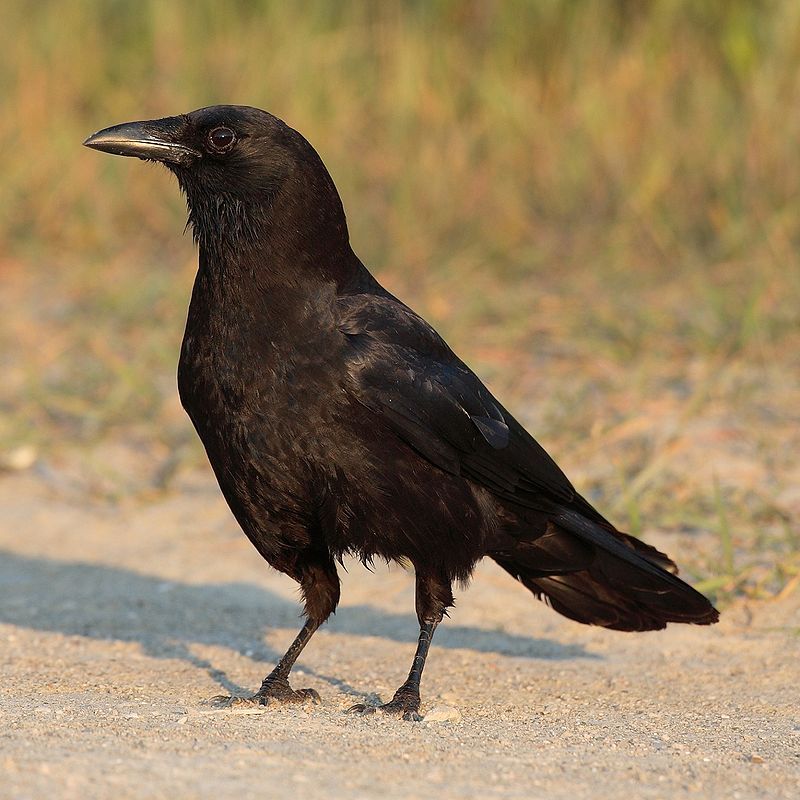
The American crow is a type of bird that belongs to the Corvidae family. This family includes other birds like ravens and jays. The American crow is extensive and known as a passerine bird, meaning it has feet adapted for perching on branches.
You can find American crows in many parts of North America. They are widespread birds; you might have seen them in your neighborhood. They have adapted well to different environments and can be found in urban areas, forests, and open fields.
Interestingly, American crows are similar to two other crows in different parts of the world. These are the carrion crow and the hooded crow found in Europe and Asia.
Despite being from different continents, these three crows occupy the same ecological niche. An ecological niche refers to the role a species plays in its environment. In this case, the American crow, carrion crow, and hooded crow have similar behaviors and habits.
They are opportunistic feeders, meaning they eat a wide range of things like insects, fruits, small animals, and even garbage. They also play essential roles in controlling populations of certain pests and scavenging.
| Kingdom | Animalia |
| Phylum | Chordata |
| Clade | Dinosauria |
| Class | Aves |
| Order | Passeriformes |
| Family | Corvidae |
| Genus | Corvus |
| Species | C. brachyrhynchos |
47. American Bushtit
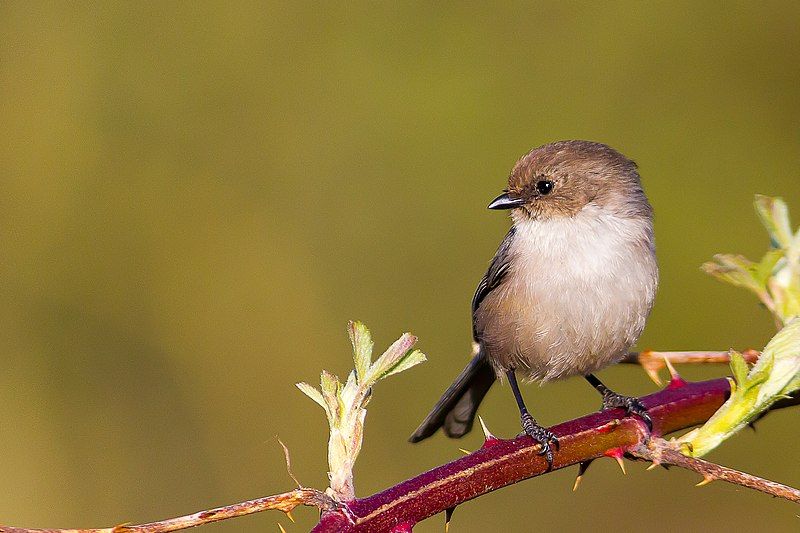
The American bushtit, also known as the bushtit, is a small songbird. It belongs to the genus Psaltriparus. It is one of North America’s smallest passerines or perching birds.
However, it is not only its size that makes it unique. Of all the species in the family Aegithalidae, the American bushtit is the only one found in the United States. The remaining seven species can be found in Eurasia.
This makes the American bushtit unique and distinct in its habitat. Being a social bird, the American bushtit often forms flocks consisting of several individuals. It enjoys the company of its fellow bushtits.
This social behavior sets it apart from some other bird species. Despite its small size, the American bushtit has a beautiful song. It uses its melodious voice to communicate with other members of its flock.
This song is an integral part of social interactions and helps maintain harmony within the group. In terms of appearance, the American bushtit has a unique look. It has a plump body with a long tail. Its plumage is generally gray-brown.
| Kingdom | Animalia |
| Phylum | Chordata |
| Clade | Dinosauria |
| Class | Aves |
| Order | Passeriformes |
| Family | Aegithalidae |
| Genus | Psaltriparus |
| Species | P. minimus |
Conclusion
Winter birds play a vital role in Utah’s ecosystem. Despite frigid temperatures and challenging conditions, these resilient avian species migrate to Utah each winter, adding beauty and diversity to the state’s landscapes.
From the colorful plumage of the Northern Cardinal to the mesmerizing flight patterns of Snow Geese, these winter visitors bring joy and wonder to birdwatchers and nature enthusiasts.
Additionally, they contribute to the balance of the ecosystem by assisting in seed dispersal and controlling insect populations.
Utah’s commitment to conservation and protection ensures the survival of these winter birds and their habitats, providing opportunities for future generations to appreciate and cherish these magnificent creatures.